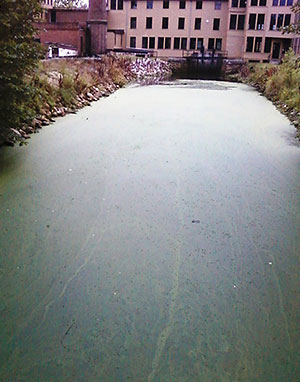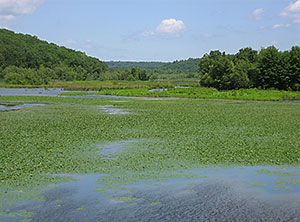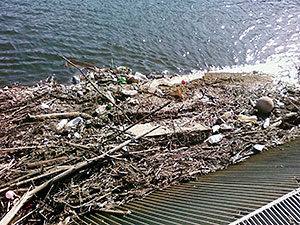Watershed Challenges
Each watershed is unique in its physical, chemical, and biological features. Each one also varies with it demographic, economic and social characteristics. As a result, we see a distinct set of challenges confronting each particular watershed. This is true for the Blackstone River watershed. The following are some of the challenges that face our watershed and the action that the BRWA is taking to address them.
Industrial Contaminants
The Blackstone River valley has been, as we all know, a region of heavy industrial use. This can be seen in the water, sediments, and physical structures connected to its waterways. Gone are the days of the river running blue or green or yellow as a result of textile mill operations. But the sediments still contain persistent chemicals that can adversely affect aquatic life. Addressing their cleanup is a complicated, expensive process. In some cases, the best solution is to leave these sediments in place rather than risk re-releasing the contaminants into the waterways during a dredging operation. In contrast, a bioremediation project called an “EcoMachine” containing aquatic plants and fungi is being used to degrade persistent oils that saturated groundwater during and after operations at the Fisherville textile mill in Grafton. The BRWA works to educate citizens, businesses and policy makers about the challenge of industrial contaminants through its eNewsletter and public programs.
Excess Nutrients

Algal bloom in the Blackstone Canal resulting from excess nutrients.
Phosphates and nitrates are natural components of chemical cycles in nature. Phosphates are important to freshwater systems like the Blackstone River while nitrates play a key role in marine environments like Narragansett Bay. However, these same nutrients, when present in elevated amounts, can upset the balance and cause mortality in aquatic animals. Phosphates in surface runoff come from detergents, septic systems, wastewater treatment plants and farms. Nitrates can enter waterways from fertilizers used on farms, golf courses and residential lawns as well as from septic systems and wastewater treatment plants. These nutrients cause excess plant growth like algal blooms that leads to a significant reduction in dissolved oxygen during the plants’ decomposition process. It is this decline in oxygen that is fatal for fish and other aquatic animals. The BRWA is addressing this challenge through public education and through its volunteer water quality monitoring program. Please look for more information to find out how you can become involved!

Asian Water Chestnut growing in Rice City Pond.
Invasive Aquatic Plants
Purple loosestrife and Asian water chestnut are two of several aquatic plant species that are not native to Massachusetts but have been introduced into our waterways with serious consequences. These plants, free of the controls found in their native habitats, are wreaking havoc on our indigenous communities. By aggressively outcompeting our native species, the loosestrife, water chestnut and other invasives are eliminating valuable food and habitat for many fish and wildlife species. They also impede recreational use of our waterways by creating large impenetrable floating mats in the case of the Asian water chestnut. Rice City Pond in Uxbridge is an example of a waterbody that has experienced this imbalance. Manual and mechanical harvesting are both used to meet this challenge. Volunteers are needed to help the BRWA combat these outbreaks. More information can be found on the NIP (No Invasive Plants) page.
Thermal Pollution
Trout, slimy sculpin, longnose sucker, and lake chub are fish species that require cooler water than most other fish, and the streams they inhabit are called “cold water fishery resources”. Sudden or significant rises in temperature can stress or even kill these sensitive fish. Thermal increases can result from industrial water discharges or from low-water events that occur during drought or drought-like conditions or when water is diverted from natural water bodies for off-site use like farm irrigation. The BRWA’s volunteer water quality monitors record water temperature during their monthly sampling visits each April through November. This data is compiled into the Blackstone River Coalition’s annual “report card.” (Adobe Acrobat document)
Turbidity
Many people do not think of sediment as a contaminant but it does, in fact, directly affect the health of aquatic communities. Construction sites, agricultural lands and projects involving large-scale tree removal can contribute large amounts of sediment into local waterways through stormwater runoff. Once in the water, the fine particles of soil have a wide range of effects on fish, plants and benthic macroinvertebrates. The latter group includes worms, mussels and snails, crayfish and isopods, and insects like stoneflies, mayflies, riffle beetles, water pennies, crane flies, and water beetles. Suspended and settled sediments suffocate eggs and larvae, impair filtering mechanisms of macroinvertebrates, interfere with fish spawning and the feeding behavior of fish and invertebrates, and affect plant growth by limiting sunlight. Even the vital breakdown of terrestrial leaf litter by macroinvertebrates can be inhibited. Turbidity in the Blackstone River and its tributaries is recorded on a monthly basis by the BRWA’s volunteer water quality monitors.

Trash and debris piled up above the Riverdale Mills Dam.
Dumping
It would be nice to think that people have learned to value our landscape enough to not trash it. However, the BRWA’s annual EarthDay Cleanup and Blackstone Valley Riverways Cleanup held each April and October respectively show just how much progress still needs to be made. Each year, hundreds of volunteers including scouts, church and school groups, outdoor enthusiasts and members of the business community help us to remove literally tons of tires, furniture, construction debris and general litter from the waterways and shorelines within the watershed. Please see our cleanup page to find out about our next event – we need your help!
